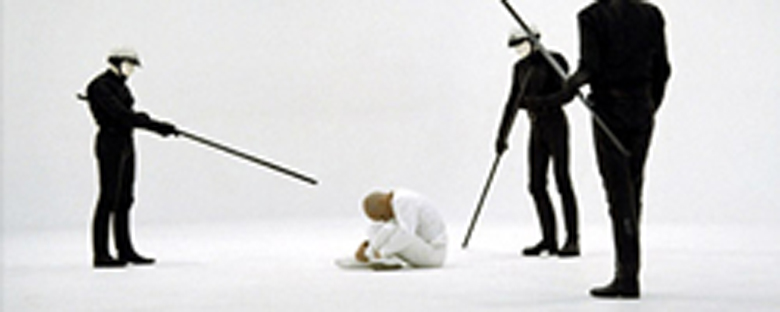Reviews
George Lucas
USA, 1971
Credits
Review by Rumsey Taylor
Posted on 17 October 2004
Source Warner Bros. DVD (Director’s Cut)
Reasonably obscured within George Lucas’ canon because of the unrivaled international success of his later science-fiction films, THX 1138 is excusably disregarded as “George Lucas’ first film.” The caption implies that this film may not be assessed individually, as it may forever be detained by comparison. This is probably true, but Lucas’ bleak debut is a film markedly dissimilar from his more famous trilogy.
The film occurs in an unspecified future. The context is ambiguously explained—Lucas frames the action in disorienting close-ups of faces and analog control boards. The mood is calm yet oddly claustrophobic and prescient. Humans are given acronymic names, look anonymous and identical in the same garments and shorn scalps, and each works in an underground factory, producing the robots that politely enforce the routine of their existence. They are ignored yet numb, regulated by daily medication and deprived innate human emotions and impulses.
The film establishes a notion of imprisonment in absence instead of seclusion. Humans have every amenity of their existence removed, and are reduced to slaves. Although each is treated benevolently, the humans have every decision made for them. The conclusive image of this unique imprisonment is delivered in a setting midway through the film, of a vastly white, empty room, an infinite ascetic space without a horizon or ceiling. There is no threat, and similarly no apparent escape.
THX 1138 is the name of one such prisoner, and the film details his defiance and resulting escape. In regard to this course of action, THX 1138 possesses characteristics of Lucas’ frequented use of religious allegory. It’s not as clear or even comparably as epic as in his later films, but THX’s rebellion is an exodus, albeit on a much smaller scale. Religion is even directly referenced in the film, in the generic recurring image of Christ (equipped with a robot voice partially reminiscent of HAL-9000) the humans are allowed confessional with.
Nearly the entire film is shot in constructed interiors, and THX’s escape can only complete in a natural setting. En route towards this desired destination, THX engages a chase sequence near the end of the film (one unnaturally paced, given the deliberation of the film’s first half) that bears Lucas’ trademark refurbishing. For the most part, THX 1138 benefits from its lack of digital effects; they would jar against the film’s analog props and video monitors skewed in monochrome static, but the chase sequence—as well as other sections of the film—has a few postmortem additions. These inclusions don’t ruin the film, but the augmented segments, as with any in a George Lucas film, display the seams of imprudent addition. This is somewhat antithetical to the film’s central theme of claustrophobia (or adverse fear of technology). Even so, Lucas’ first film is noticeably ambitious.
We don’t do comments anymore, but you may contact us here or find us on Twitter or Facebook.



